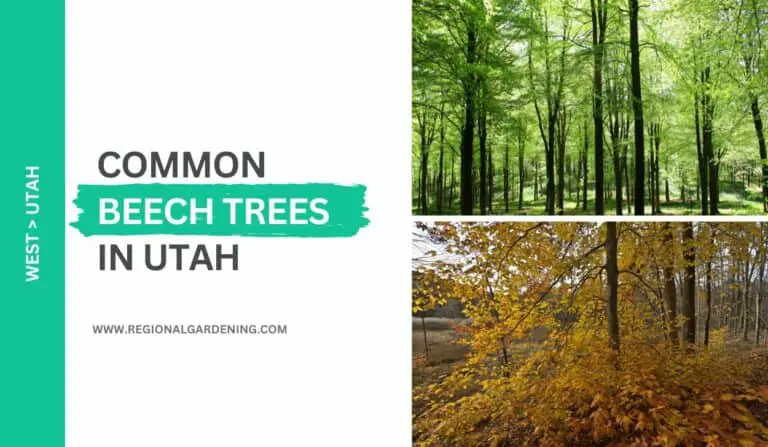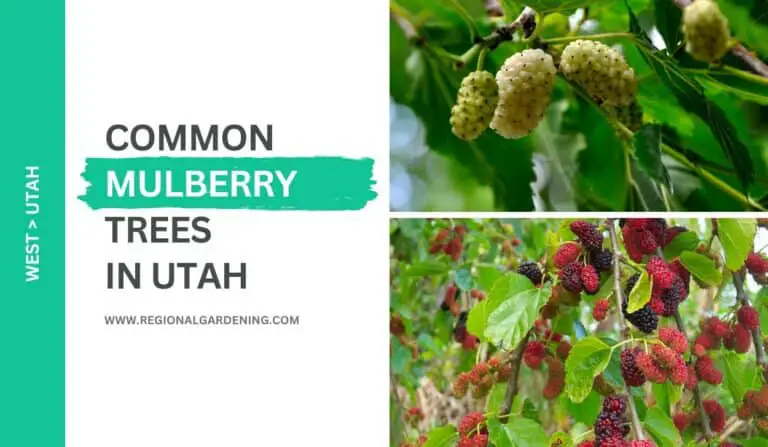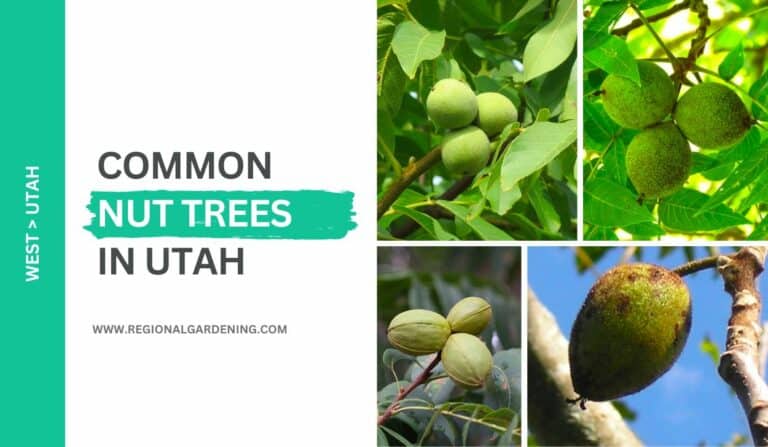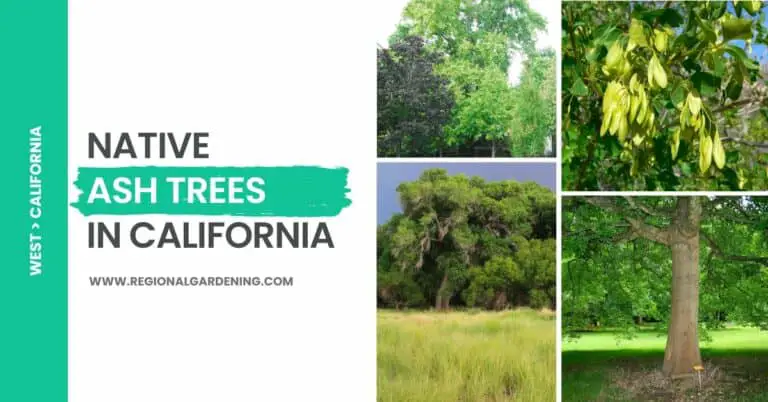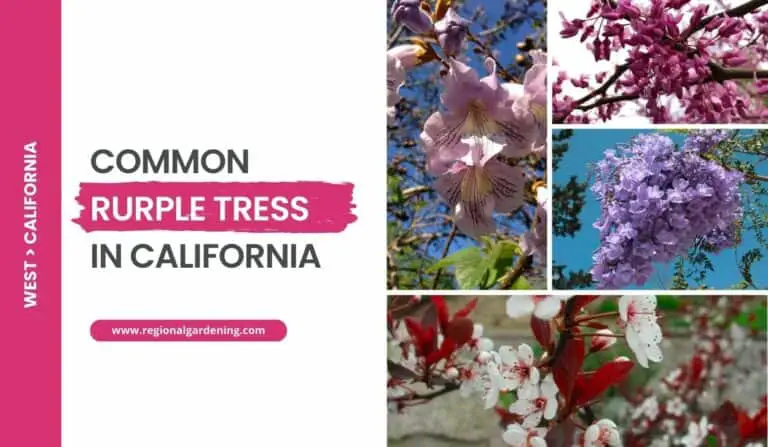5 Common Magnolia Trees In Utah (With Stunning Flowers)
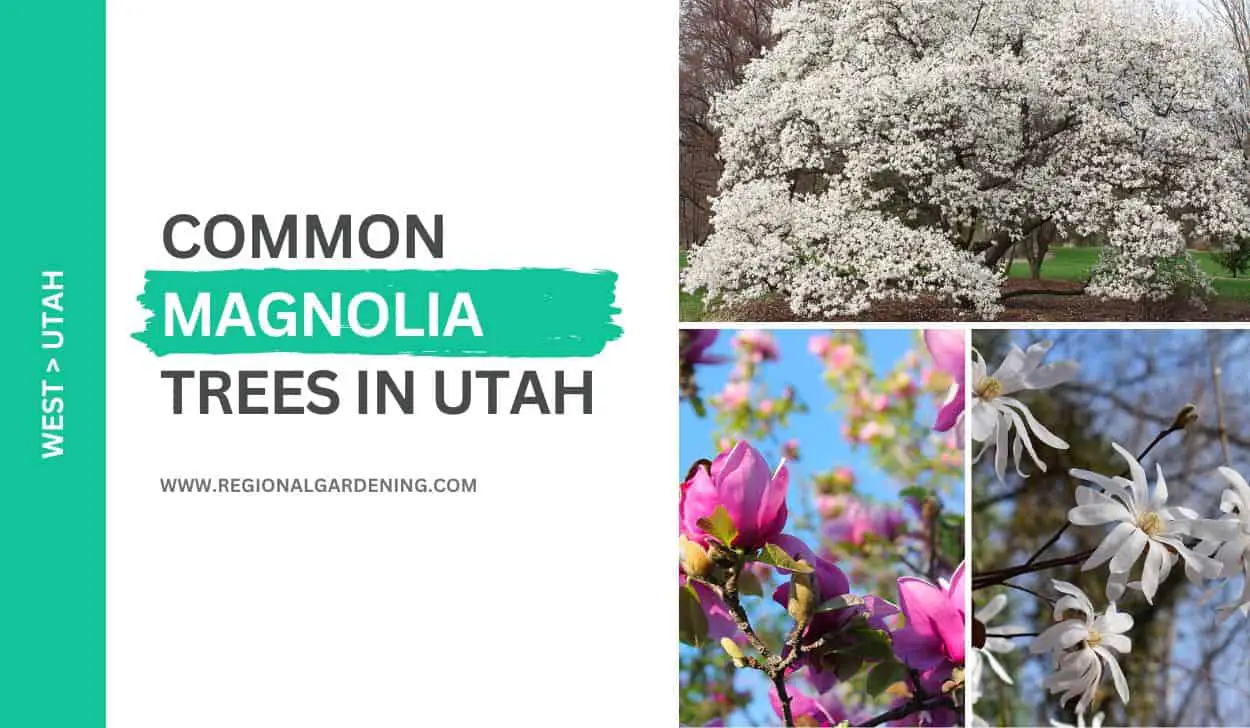
If you are looking for some amazing flowering trees for your Utah backyard, then planting some magnolia trees is a great choice.
There are between 70 and 80 species of the Magnolia genus, the majority of which stand out thanks to their sizable, distinctive flowers. There are eight native species in North America, with none found naturally in Utah. However, there are at least five different species that have become naturalized in the state over the years.
And, this article delves into the five non-native commonly found magnolia trees in Utah, complete with high-quality photos, physical characteristics, and care instructions.
So, let’s get started.
1. Southern Magnolia
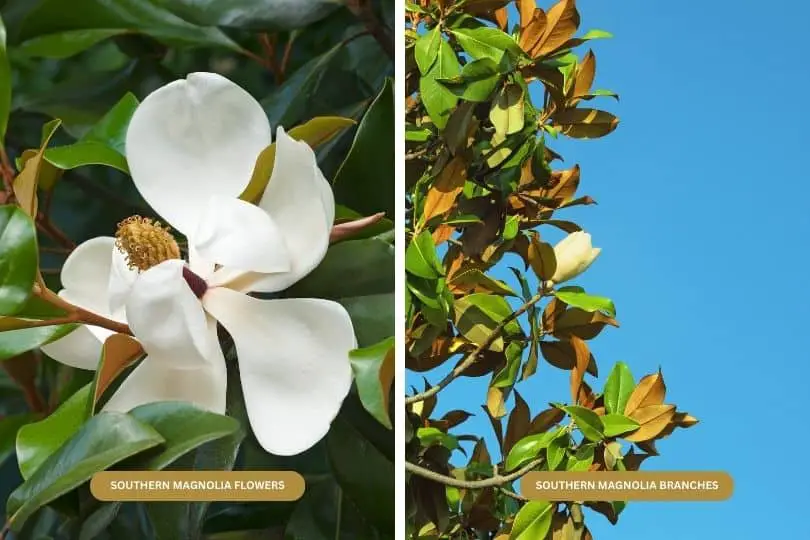
- Common Name: Southern Magnolia
- Scientific Name: Magnolia grandiflora
- Mature Height: Up to 80 feet tall
- Native: Native to the southeastern US
- Flowers/Cones: Large, fragrant, white flowers with 6 to 12 petals; red fruit
- Uses: Ornamental tree for landscaping
One of the most commonly found and showy magnolia trees in Utah, the Southern Magnolia is a lovely evergreen tree that can grow to be up to 80 feet tall. It has oval to ovate leaves that can grow 5 to 10 inches long and 2.5 to 4 inches wide.
The Southern Magnolia keeps its leaves for two years before shedding them in warm regions, but in cooler climes (usually zones 5 and colder), they may turn brown and fall off. The leaves are dark green and lustrous on top, but densely red-lined and thick like leather on the underside.
The twigs of the tree are thick and green, and they might be coated in red hairs or bald. Terminal buds are 1 to 1.5 inches long and coated in white or red silky hairs, whilst lateral buds are smaller.
Every spring, the Southern Magnolia produces big, fragrant white flowers with 6 to 12 petals that can grow up to 10 inches in diameter. The fruit of the tree is similar to that of the cucumbertree, except it is fuzzy red and 3 to 4 inches long.
On older trees, the bark of the Southern Magnolia is thin, brown to gray, and flaking.
Southern Magnolia is indigenous to the southeastern United States, ranging from southeast Texas to eastern North Carolina. It can withstand partial shade and prefers rich, well-drained soil. While it is not widely planted in Utah, it can thrive in warm enough environments.
The tree has huge, lustrous leaves and a strong pyramidal to oval form, making it a popular tree for landscaping in areas where it is hardy. Southern Magnolia grows best in zones 7 to 9 and requires winter wind and sun protection in cooler northern locations.
2. Saucer Magnolia
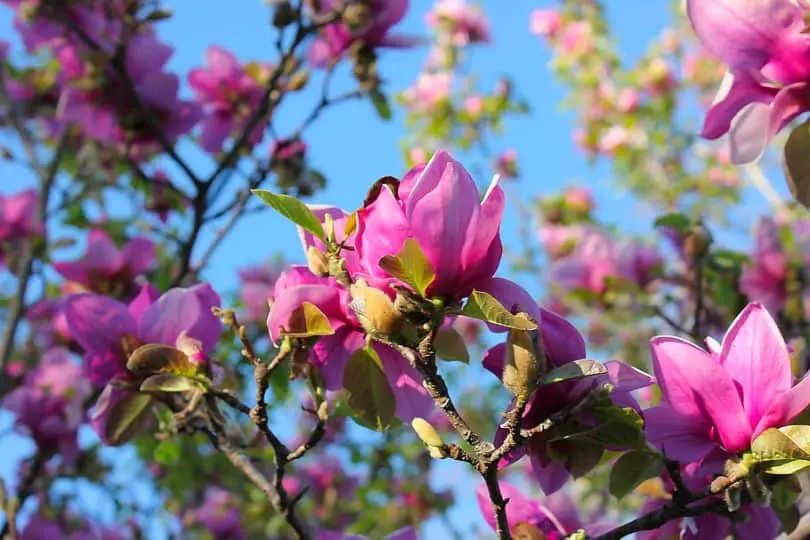
- Common Name: Saucer Magnolia
- Scientific Name: Magnolia soulangiana
- Mature Height: Upto 10ft
- Native: China & Asia
- Flowers/Cones: Large showy flowers in shades of white, pink, and purplish
- Uses: Attractive landscaping tree with beautiful flowers
One of the most commonly found non-native magnolia trees in Utah, the Saucer Magnolia is a lovely tree with brilliant flowers. It is a cross between two Chinese magnolias.
The Saucer Magnolia’s leaves are simple and range in form from obovate to broadly rectangular. They range in length from 3 to 6 inches and width from 1-1/2 to 3 inches. The dark green leaves are deciduous and have a narrow, pointed apex.
The twigs are chestnut and fairly robust, and the terminal buds are silky and 1/2 to 3/4 inch long. Some of the Saucer Magnolia’s outstanding attributes are its blossoms. They are 5 to 10 inches tall and open before the leaves in the spring.
The flowers range in color from white to pink to purple and are frequently pink to purple on the outside and whitish on the inside.
The Saucer Magnolia is a non-native tree that thrives throughout much of Utah. It’s a small to medium-sized tree with gray bark on aged trunks. The tree dislikes shade and wants to be in the sun. Late frosts, on the other hand, can harm flower buds.
The Saucer Magnolia’s fruit is a clump of follicles that matures in August-September. While there is no information available regarding the wood of this tree, its magnificent and striking blossoms make it an excellent addition to any garden.
3. Star Magnolia
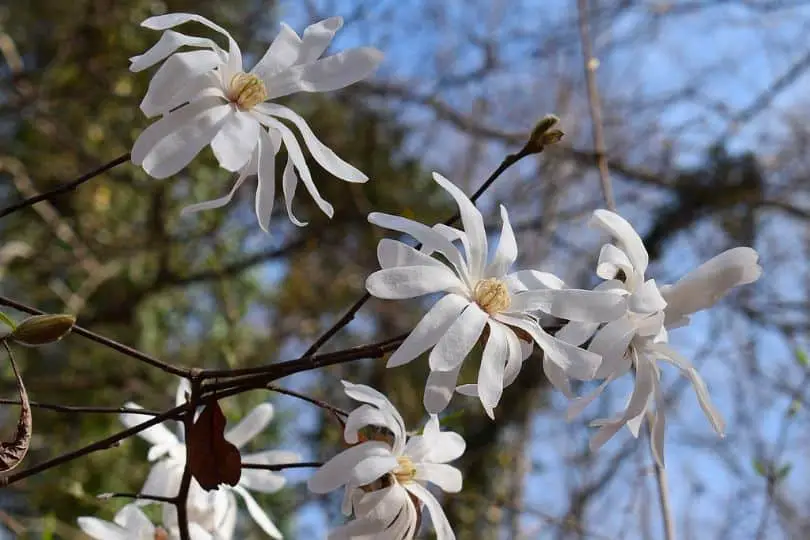
- Common Name: Star Magnolia
- Scientific Name: Magnolia stellata
- Mature Height: 15-20 feet
- Native: Native to Japan
- Flowers/Cones: Large white flowers with narrow petals
- Uses: Ornamental purposes in landscaping
The Star Magnolias are the most beautiful and showy magnolia trees in Utah. This little tree is native to Japan, but it is quite popular in Utah due to its stunning blossoms.
The Star Magnolia can reach a height of 15-20 feet and has obovate or narrow-elliptical deciduous leaves that are dark green and glabrous on top and paler and generally glabrous on the bottom.
The striking white flowers have numerous narrow, fairly long petals that can be as much as 3-4 inches in diameter. The flowers are so beautiful that they can appear before the leaves!
If you wish to plant a Star Magnolia in your yard, keep in mind that it is shade intolerant and should be planted where it will be protected from the hot winter sun. This could be along a building’s north side or with evergreens to the south and southwest.
The Star Magnolia is quite hardy, growing best in zones 4-9.
4. Cucumber Magnolia
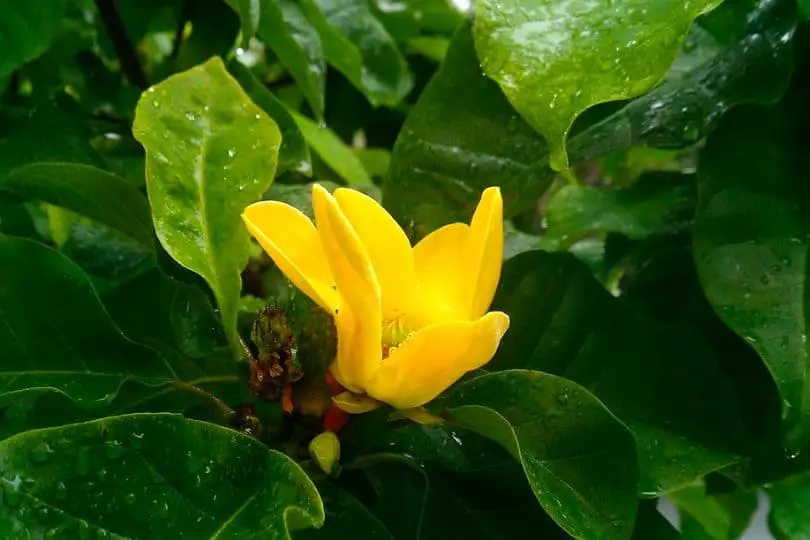
- Common Name: Cucumbertree
- Scientific Name: Magnolia acuminata
- Mature Height: 40-60 feet
- Native/Non-Native: Non-native
- Flowers/Cones: 6-petaled white-to-yellow flowers, cone-shaped fruit
- Uses: Ornamental, lumber, wildlife food source
Cucumbertree, sometimes known as Cucumber Magnolia, is a deciduous tree with broad, elliptic leaves 6 to 10 inches long and 4 to 6 inches wide. It can reach mature heights of 60 to 80 feet.
This tree is indigenous to the Appalachian Mountains as well as the lower Mississippi and Ohio River valleys. It is most widespread in the eastern United States and may thrive in zones 3-8. Cucumbertree may grow in a variety of soil types but favors moist, well-drained soils.
This tree produces non-showy yellow-green flowers that are 2 to 3 inches across in May or June. At maturity, its fruit is an aggregate of follicles 2 to 3 inches long, held erect, with crimson seeds suspended from delicate threads.
Cucumbertree does not tolerate shade. When crushed, its twigs are glossy, dark to red-brown and have a spicy odor. Terminal buds have silvery, silky hairs, whereas lateral buds are smaller.
Cucumber trees can be grown in Utah, but they are commonly seen in the state. This tree is mostly utilized for ornamentation or as a supply of wood. Cucumbertree’s bark is furrowed into small flaky ridges, and the leaves are yellow-green in hue, making it an aesthetically pleasing addition to any garden.
5. Kobus Magnolia
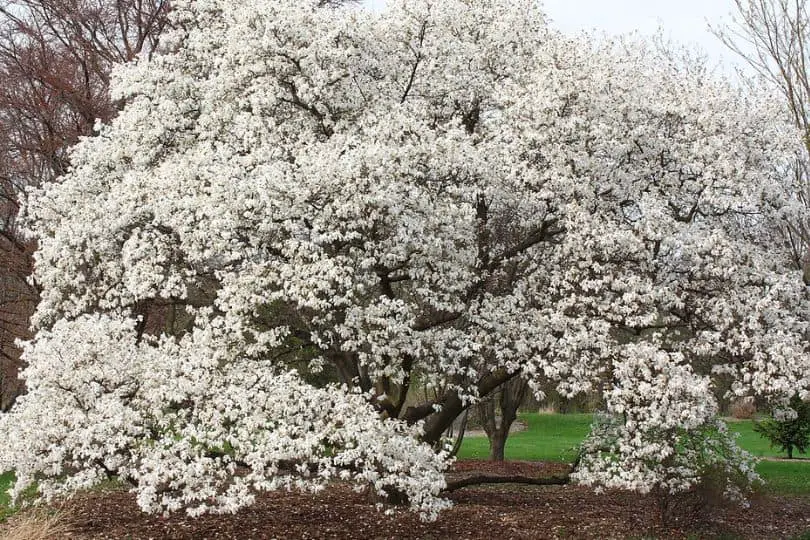
- Common Name: Kobus Magnolia
- Scientific Name: Magnolia kobus
- Mature Height: Upto 10ft
- Native: Native to Japan
- Flowers/Cones: Showy white flowers
- Uses: Suitable for landscaping
The Kobus Magnolias are another non-native commonly found magnolia tree in Utah. It is a beautiful shrub or tree that can grow up to 30 to 40 feet tall depending on the variety. This plant is native to Japan and is uncommon in Utah, but it is worth a try because it is more cold-hardy than most magnolias and tolerates a variety of soil conditions.
Kobus Magnolia leaves are generally obovate to ovate, 3 to 6 inches long, and have a pointed apex. They are deciduous, dark green, and glabrous on top and paler, glabrous, or somewhat hairy on the veins below. The leaves have a subtle autumn hue, and the petiole is roughly 1/2 to 3/4 inches long.
Kobus Magnolia twigs are somewhat stout and brown, with terminal buds that are big and covered in silvery, silky hairs. The lateral buds are more compact. This plant’s flowers are white, 4 to 5 inches in diameter, and occur in March or April. The Kobus Magnolia fruit is a clump of 3 to 5-inch long follicles standing erect.
The bark of the Kobus Magnolia ranges from brown to gray. This plant prefers full sun and is shade intolerant. Kobus Magnolia is hardy in zones 3-8 and is a good choice for gardeners looking to add a unique plant to their yard.
It is a beautiful plant to observe, with its white flowers, glabrous leaves, and tall stature. Its tolerance to a variety of soil conditions, as well as its winter hardiness, make it an ideal choice for gardeners in zones 3–8.
Common Magnolia Trees In Utah – Frequently Asked Questions (FAQs)
Let’s go through some of the most commonly asked questions about magnolia trees in Utah on different forums and threads related to gardening and trees.
Is magnolia a tree or a plant?
Magnolia is a genus that includes trees and shrubs. As a result, it can apply to both trees and plants. The magnolia genus is known for its diverse species, with some growing to be large trees and others remaining small shrubs. Magnolia trees are prized for their beautiful flowers, while shrub varieties are prized for their foliage and compact growth habit.
Are there magnolia trees in Utah?
Yes, there are magnolia trees in Utah. While magnolia trees are most commonly associated with the southeastern United States, several magnolia species can be found in Utah and other parts of the country.
The saucer magnolia (Magnolia soulangeana), the star magnolia (Magnolia stellata), the cucumber magnolia, and the southern magnolia (Magnolia grandiflora) are among the magnolia species found in Utah. These trees are well-known for their lovely, fragrant flowers, which bloom in a variety of colors depending on the species.
What are the uses of magnolia trees in Utah?
Despite having multiple uses, magnolia trees in Utahares primarily used for ornamental purposes. These trees are frequently planted in gardens, parks, and landscapes to improve their aesthetic appeal. Magnolias add aesthetic appeal to outdoor spaces with their lovely flowers and attractive foliage.
Because of their large, dense canopies, they also provide shade and privacy when strategically placed. Many magnolia species’ fragrance adds a delightful aroma to gardens, making them popular choices for scented landscapes. Furthermore, these trees provide habitat for wildlife by providing shelter and food for birds as well as attracting pollinators such as bees and butterflies.
Some magnolia species have medicinal properties and are used in traditional and alternative medicine for anti-inflammatory, antifungal, and anti-anxiety properties. However, before using magnolia for medicinal purposes, seek professional advice.
Similar Articles
- Common Oak Trees In Utah
- Common Pine Trees In Utah
- Common Mulberry Trees In Utah
- Common Ash Trees In Utah
- Common Spruce Trees In Utah
- Common Elm Trees In Utah
- Common Birch Trees In Utah
- Common Maple Trees In Utah
- Common Dogwood Trees In Utah
- Common Poplar Trees In Utah
- Common Nut Trees In Utah
- Common Pear Trees In Utah
- Common Cedar Trees In Utah
- Common Willow Trees In Utah
- Common Alder Trees In Utah
- Common Cypress Trees In Utah
- Common Beech Trees In Utah
- Common Juniper Trees In Utah
- Common Fir Trees In Utah
- Common Plum & Cherry Trees In Utah
Sources
The Regional Gardening team makes sure that the information in our articles is accurate by only using sources that are known to be trustworthy. Some of these sources are peer-reviewed journals from government agencies, well-known universities, and scientific research organizations.
- Trees & Shrubs In Yard And Garden, Utah State University Extension
- Native & Non-Native Tree Identification, Utah State University Forestry Extension.
- Native Plants, Utah Native Plant Society.
- A Guide To The Trees Of Utah & Intermountain West, Book By Michael Kuhns, Utah State University Press.


